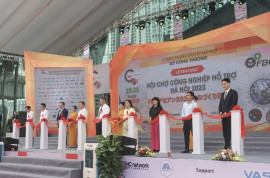In the typical cost structure of a supporting industry enterprise, raw materials can contribute 50% - 60%. According to the 80-20 principle, this is a key point in the management and improvement of costs of manufacturing enterprises.
Traditionally, the basic formula for calculating the cost of raw materials is usually calculated as the nominal cost by the formula: RMC = V x D x UP, where RMC is the cost of raw materials for 1 unit of product, V is the volume of material required for 1 unit of product, D is the density of the material and UP is the unit price of the material. For example, in case a product after processing has the form of steel plate with dimensions of 480 mm x 670 mm x 1.2 cm, manufactured from a steel sheet of size 1000 mm x 2100 mm x 12 mm with the unit price delivered at the warehouse. is 18,000 VND/kg. Then the norm of materials per unit of product will be 500 mm x 700 mm x 12 mm and the unit price of raw materials for 1 product will be RMC = (50 (cm) x 70 (cm) x 1.2 (cm) x 7.85 (g/cm3) x 18000 (VND/kg)) / 1000 = 593,460 VND. However, in reality during the production process, the costs incurred in the purchasing management process make the original calculations more and more unreliable.
The use of standard costing creates a "blind spot" in cost management in production in which management personnel in the enterprise may default to this as an irreplaceable standard. change, happy to achieve and lose motivation for continuous improvement of these norms.
In addition to the blind spot above, this article analyzes 6 common cost losses for purchasing activities in a manufacturing plant.
- Scrap rate loss
In the calculation of normative costs, the cost of raw materials is usually determined with a certain loss rate (due to loss, marginal material, .....) for each product code. Going back to the above example, the actual weight of the product with dimensions of 480mm x 670mm x 1.2mm is 30.29kg while the rated mass of 500mm x 700mm x 1.2mm will be 32.97kg. Then the loss rate (marginal material) is equivalent to 8.1%, and with the proportion of material cost, say, at 57%, this loss ratio corresponds to 4.62% of the cost of production. export.
In addition, in practice there are some cases where this cost is out of control. Firstly, the specification standards of raw materials may be changed from the original. For example sheet size 1010 mm x 2150 mm instead of 1000 mm x 2100 mm as above will cause a loss of 11.14% instead of 8.1%. Second, using the same material specification for different product codes can make ordering easier. For example, using the same material pipe with a length of 6000 mm to process two different billet products with a length of 570 mm and 680 mm will have very different loss rates, 4.75% and 8.54% respectively. .
- Loss of canceled goods due to quality defects
Depending on the characteristics of the product and the processing technology, each enterprise or product may have a different amount of defective goods. With defective goods, the materials used for these products will be completely lost. In some cases, especially in the early stages after "exploitation", this loss can be as high as 3% - 7%, equivalent to about 1.5% - 3% of the production cost.
For example, a processing order has a material cost ratio of 57% and an allowable defect rate of 1.5%. If the enterprise achieves this norm, this 1.5% loss causes a loss of 0.86% of production cost. While if the cancellation error rate exceeds 2.5%, it will cause a loss of 1.43% of production costs – a difference of 0.57%. If the expected rate of return is 4%, then this cost loss is equivalent to 14.25%.
- Cost of inventory
The cost of inventory of raw materials is usually included in general management costs, which can be at 3% - 5%, during the calculation of quotation and production cost. However, operational problems can arise that alter these norms significantly, especially during periods of high credit interest rates.
The cost of inventory usually consists of four main components: inventory cost, inventory management cost, inventory risk management cost, and storage cost. First, the cost of inventory capital is closely related to the quantity and duration of inventory of raw materials. A Lean transformation report said that after a Lean transformation for a product line, a business was able to reduce the raw material inventory time from 45 days to 10 days. Assuming an internal rate of return (IRR) of 15% per year, then the pre- and post-improvement cost of capital is equivalent to 1.88% and 0.63% of the value of the raw material – equivalent to equivalent to 1.07% and 0.36% of production cost, with a material cost ratio of 57%. The difference before and after improvement is equivalent to 0.71% of production cost and 14.25% of profit.
In addition, the inventory of raw materials also entails inventory management costs (counting, bookkeeping, quality control, ...) associated with labor time, risk management costs - related to the level of pay insurance premiums for assets, and storage costs – including space, warehouse equipment system.
Thus, the increase or decrease in raw material inventory has a strong impact on profitability in production. Regardless of the decisions or incidents that lead to an increase in raw material inventory, production costs increase rapidly leading to the erosion of profits at an even faster rate.
- Additional loss on delivery
In the majority of current purchasing cases, unit prices are usually determined along with the minimum order lead time and minimum order lot size (MOQ). When, for whatever reason, an order is made with a batch size smaller than the agreed MOQ or a lead time less than the agreed time, you will be charged an additional fee for these orders.
Assume that delivery costs represent 3% of the cost of raw materials and that additional charges apply at 15%. Then with the ratio of raw material cost accounting for 57% of production cost, the additional cost of delivery will be 0.45% of the cost of raw materials and 0.26% of the total cost of production.
- Unusual expenses incurred in purchasing
In addition to the four main costs analyzed above, purchasing activities also come with costs incurred when there are irregularities in the purchase – be it in quality, time or quantity. These additional costs may include having to stop production for materials, confirm quality, and implement problem-solving procedures, which may include unscheduled additional audits with suppliers. and follow up to confirm their reciprocal countermeasures.
Thus, to be able to continuously optimize production costs for the purpose of increasing competitiveness, optimizing purchasing costs needs to be an important piece in the annual cost optimization plan of the whole company. enterprise.
Author: Pham Minh Thang, Director of P&Q Solutions

















